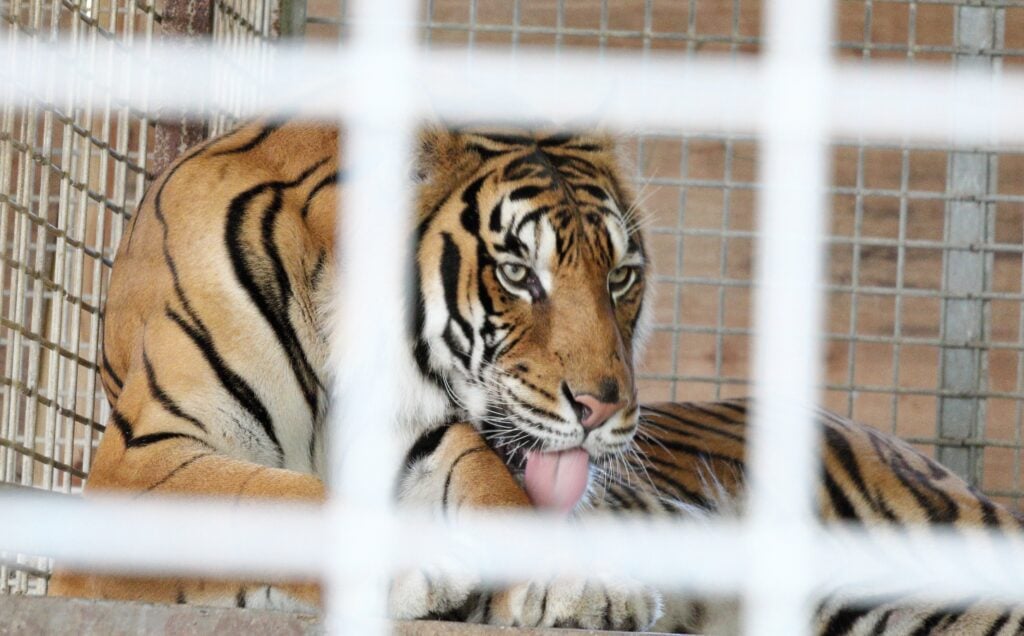In July, Mexico City’s Black Jaguar-White Tiger Foundation, which claims to operate as an animal rescue, was shut down by officials. More than 200 animals were relocated to zoos and credible sanctuaries.
Complaints of animal cruelty were sent to Mayor Claudia Sheinbaum’s office by previous employees and animal rights activists. Both submitted video evidence of emaciated animals and poor conditions, which Profepa, Mexico’s environmental protection agency, used as grounds for a raid.
Amongst the animals discovered were around 200 big cats, including lions, tigers, jaguars, and pumas, in addition to primates, dogs, and more. The Association of Zoos, Breeders, and Aquariums of Mexico (AZCARM) spearheaded relocation efforts.
In the past, The Black Jaguar-White Tiger Foundation has welcomed a slew of celebrity visitors, including Paris Hilton, The Kardashians, and Katy Perry. All posed for selfies with animals. It has also received donations from high-profile individuals, with Formula One champion and passionate vegan Lewis Hamilton counted amongst them.
However, owner Eduardo Serio claims that since the beginning of the pandemic, donations have fallen by 70 percent, leaving him struggling to make ends meet. This claim has been countered by a former employee who told El Universal: “Money was coming in and it was not used for the animals. Their tails were ripped out due to hunger.”
Video footage shows dangerously thin animals with missing tails, ears, and other external body parts, leading to claims that they have been eaten out of desperation.
Eduardo Serio claims innocence
Serio says that footage of the animals he was charged with caring for has been taken out of context. In an interview with Televisa, he said: “In general, our little animals have suffered a bit from the [pandemic] crisis because they are a little thinner.”
“But when Profepa showed up, the animals were at 90 to 95 percent of their weight. The ones [in the videos], which look terrifying, were animals that we were trying to rescue. They were taken out of context.”
Serio went on to claim that tails had been lost due to necessary amputations after play fights resulted in a loss of sensitivity.
Ernesto Zazueta, President of AZCARM, is calling for Serio to be prosecuted to the full extent of the law, referring to him as a “pseudo-animalist.”
“This man, as well as the owners of other [disingenuous] animal rights foundations, become very famous and rich through lies and deceit. They are not wildlife specialists. They are only very good at profiting from animals, and when they achieve their economic goals and feed their enormous ego, they simply forget about them and let them die,” he told Mexico News Daily.
When is an animal sanctuary not a real sanctuary?
Since the closure of the Black Jaguar-White Tiger Foundation, legal notices have been put up around the site, informing the public of animal abuse claims. A secondary offense of operating a sanctuary without a permit is also listed.
It is possible to identify a legitimate animal rescue sanctuary, prior to visiting. PETA lists a number of key markers to watch out for, including the way animals are housed and how spacious it is. You should also check the enrichment activities included, and how large the overall “sanctuary” is.
Other things to be wary of are opportunities to hold exotic animals and how animals are acquired by sanctuaries. They should be housed as part of a rehabilitation operation, not bought or traded, and definitely not bred. There should also be a no-kill policy in place. Finally, accreditations are a good indicator that a sanctuary has been founded on ethical principles, with animal welfare at its core.
Animals that are housed in a genuine sanctuary should look well cared for, peaceful, and have enough space to freely interact how they choose with human visitors. They should not be displayed as attractions or expected to perform. These are indicators of a zoo or other private endeavors.






